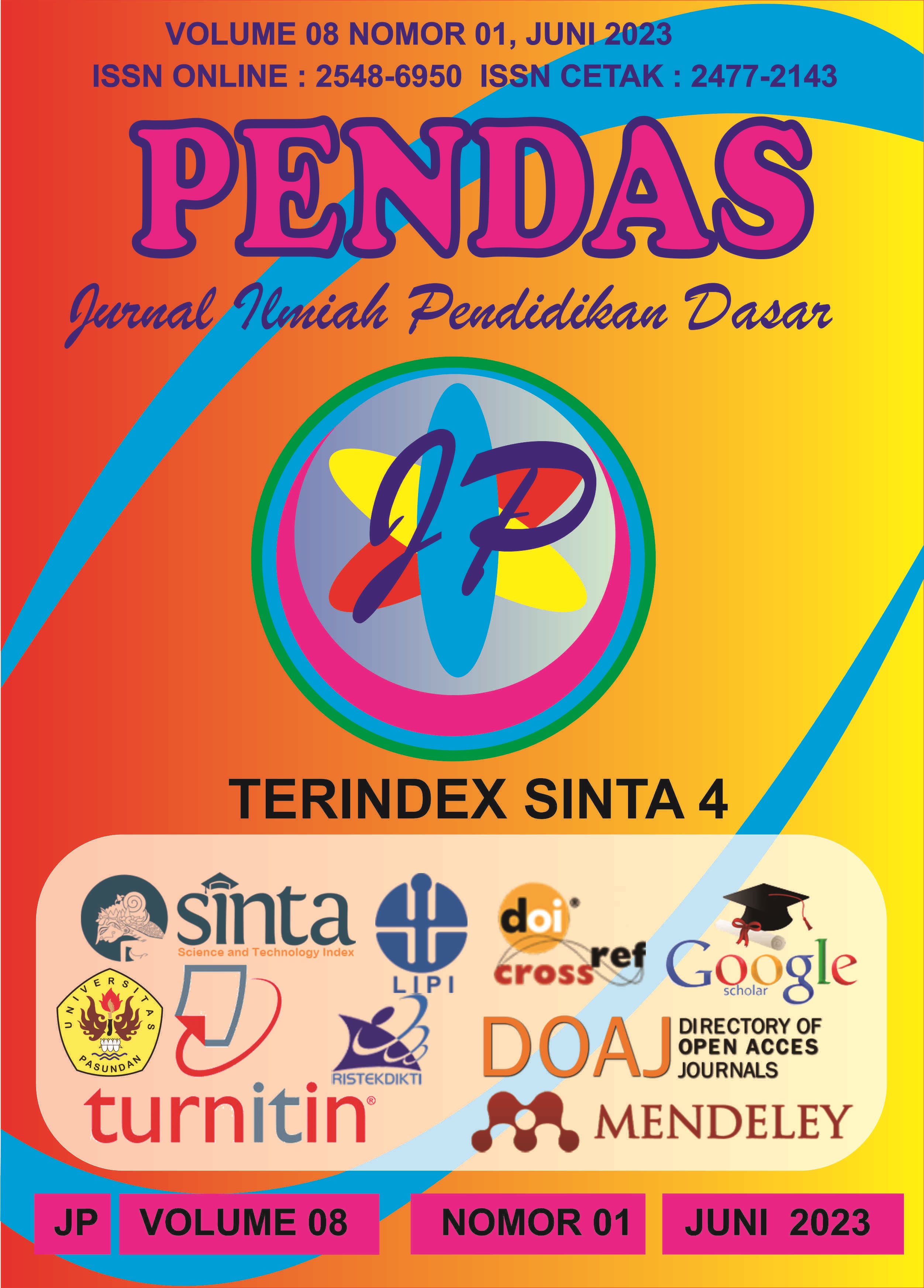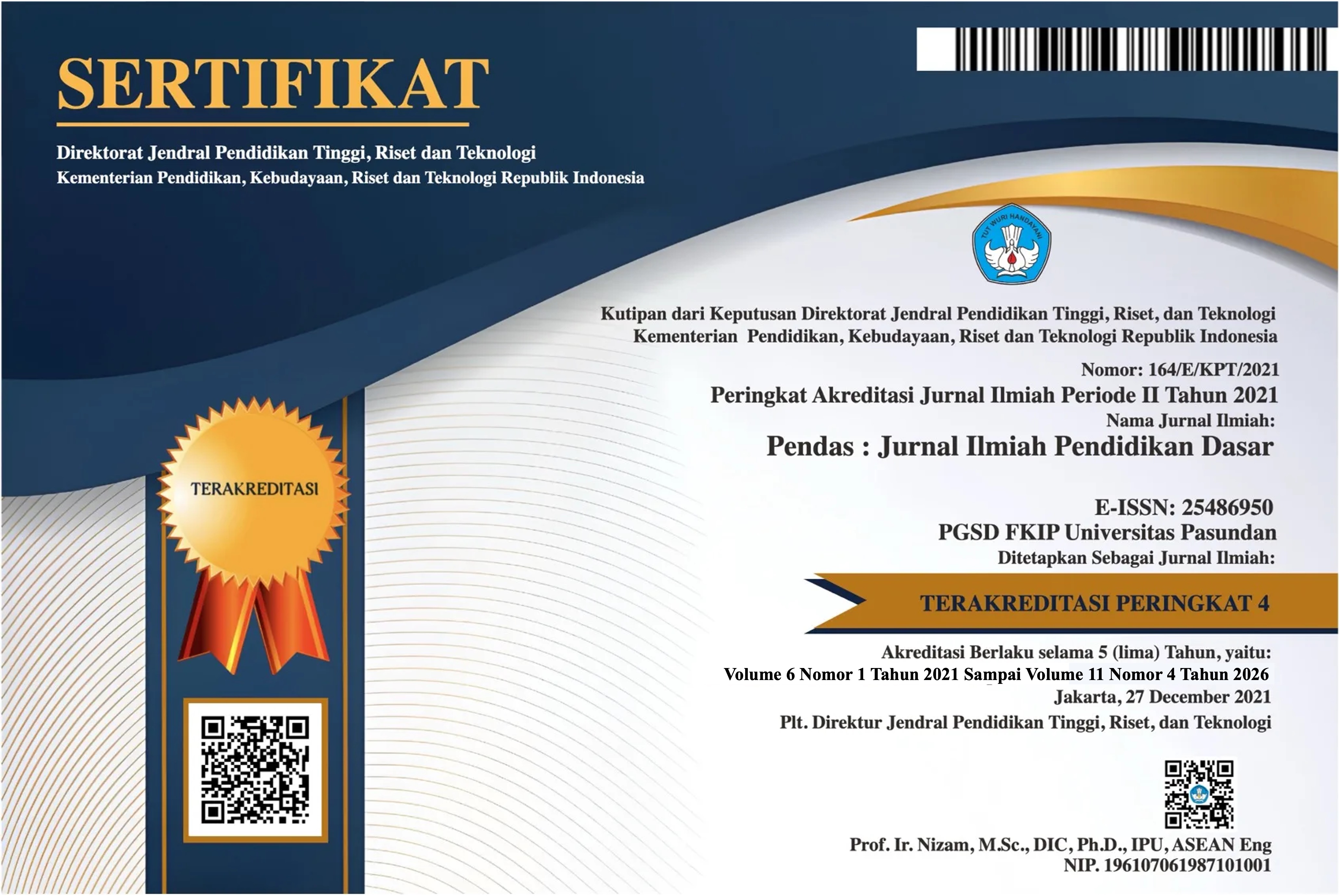PENGARUH PROBLEM BASED LEARNING (PBL) BERBANTUAN CANVA TERHADAP STUDENT WELL BEING DAN HASIL BELAJAR IPA SISWA SD PADA MATERI UDARA BERSIH BAGI KESEHATAN
DOI:
https://doi.org/10.23969/jp.v8i1.7606Keywords:
Problem Based Learning Model, Student Well Being, Science Learning OutcomesAbstract
This study aims to determine the effect of the Canva-assisted Problem Based Learning (PBL) learning model on student well being and science learning outcomes for fifth grade elementary school students. The research method uses a quantitative research design with research instruments in the form of questions and questionnaires given during the pretest and posttest. Data analysis used the Mann Whitney Test statistic for the independent sample test data and the Wilcoxon Test for the data dependent sample test. The population used was all fifth grade elementary school students from four elementary schools in Subang district. The results of research on student well being in the experimental class through the Wilcoxon Signed rank test showed that the average student well being before using the Canva-assisted problem-based learning model was 13.50 while the average student well-being after using the Canva-assisted problem-based learning model became 28.32 and a Z value of -6.135 and a Sig.(2-tailed) value of 0.000 is smaller than the α(0.05) level so that it rejects Hₒ and accepts Hₗ, so the conclusion is that there is an influence of the problem-based learning model assisted by Canva on student well being in class V Elementary School. The average value of science learning outcomes for fifth grade elementary school students before the Canva-assisted problem-based learning model was 0.00 while the average learning outcomes after the Canva-assisted problem-based learning model was 30.00 and a Z value of -6.705 was obtained and a Sig.( 2-tailed) 0.000 is less than the level α(0.05) so that it rejects Hₒ and accepts Hₗ, so the conclusion is that there is an effect of the Canva-assisted problem-based learning model on learning outcomes in science for class V elementary school.Downloads
References
Ramadhon, Mukminin.A, Muazza (2021).Kompetensi Guru dalam menggunakan Media Pembelajaran berbasisi Teknologi, Informasi, dan Komunikasi pada masa Pandemi COVID-19 di MIS Darussalamm Kec. Jalutung Kota Jambi dalam menggunakan Media Pembelajaran Berbasis Teknologi, Informasi, dan Komunikasi. Diunduh dari https://doi.org/103835/jmpis,v21l.
Frost, P. (2010). The Effectiveness of Student Well-being Programs and Services. Victorian Auditor-General's Report. Diunduh dari http://download.audit.vic.gov.aulfiles/290110-StudentWellbeing-Full- Report.pdf.
Mubarizi, A. F., Pangestuti, H., Selviana, M., & Saputri, A. (2020). Dampak Covid-19 Terhadap Kesejahteraan Psikologis ( Psycal-Well-Being ) Selama pembelajaran Daring Di Sekolah Dasar Kabupaten Batang. Dampak Covid-19 Terhadap Kesejahteraan Psikologis (Psycal-Well-Being) Selama Pembelajaran Daring Di Sekolah Dasar Kabupaten Batang, 24(1), 1–6.
Muhammad Arsyad. (2010). Maksimalisasi Fungsi Layanan Bimbingan dan Konseling untuk Menciptakan Kesejahteraan Siswa (Student Well-being) di Sekolah. Fitrah, 01(02), 12. http://eprints.ulm.ac.id/id/eprint/5582
Resmini’, S., Satriani, I., & Rafi, M. (2021). Pelatihan Penggunaan Aplikasi Canva sebagai Media Pembuatan Bahan Ajar dalam Pembelajaran Bahasa Inggris. Abdimas Sliwangi, 04(02), 335–343. https://journal.ikipsiliwangi.ac.id/index.php/abdimas-siliwangi/article/view/6859/2593
Maryanti, E., Ilyas, M., & Palopo, U. C. (2021). Pengaruh Subjective Well Being Dimasa Pandemi Covid-19.
Komunikasi, F., & Inovasi, D. (2022). Pemanfaatan Canva Sebagai Media Perancangan Grafis melejit dengan membukukan rekor Salah satu pemasukan terbesarnya datang dari pengguna premium yang berjumlah sebanyak. 6(74), 62–68.
(Dalyono & Agustina, 2016)Dalyono, B., & Agustina, D. A. (2016). Guru profesional sebagai faktor penentu pendidikan bermutu. Polines, 2, 13–22. https://jurnal.polines.ac.id/index.php/bangun_rekaprima/article/view/453.
Rahayu, W. P., Zutiasari, I., & Munadhiroh, S. (2021). Learning Media of Canva Based on Flipbook in the Subjects of Creative Products and Entrepreneurship to Improve Students’ Digital Technopreneurship Competence. Proceedings of the Sixth Padang International Conference On
Monoarfa, M., & Haling, A. (n.d.). Pengembangan Media Pembelajaran Canva dalam Meningkatkan Kompetensi Guru. 1085–1092.
Tuma, F. (2021). The use of educational technology for interactive teaching in lectures. Annals of Medicine and Surgery, 62(January), 231–235. https://doi.org/10.1016/j.amsu.2021.01.051
Kunandar, 2013. Penilaian Autentik (Penilaian Hasil Belajar Peserta Didik Berdasarkan Kurikulum 2013). Jakarta : PT. Rajagrafindo Persada.
Winarso, Bambang (2018). Menjajal Canva di Smartphone, Wow Simple Banget. (Review App, 28 Desember 2018). Retrieved from https://dailysocial.id/post/menjajalcanva-di-smartphone
Downloads
Published
Issue
Section
License
Copyright (c) 2023 Pendas : Jurnal Ilmiah Pendidikan Dasar

This work is licensed under a Creative Commons Attribution 4.0 International License.



















